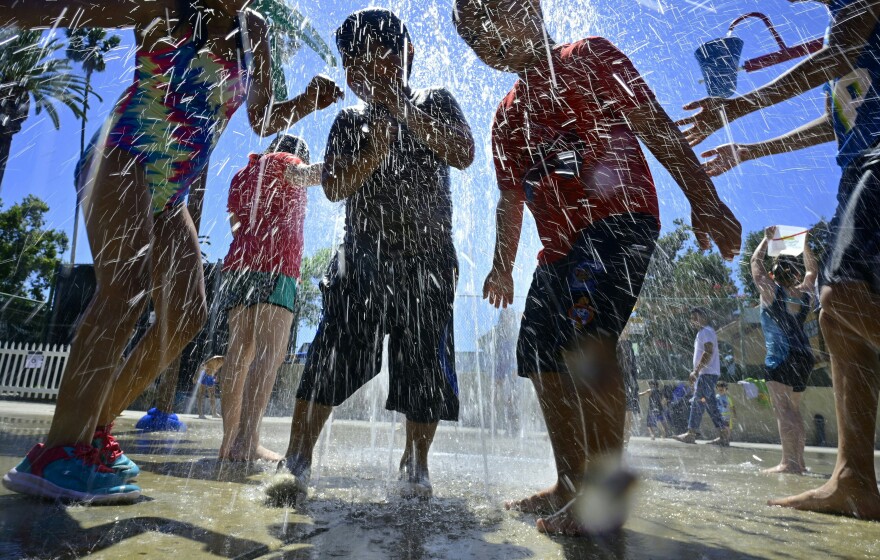Truth matters. Community matters. Your support makes both possible. LAist is one of the few places where news remains independent and free from political and corporate influence. Stand up for truth and for LAist. Make your tax-deductible donation now.
It’s hot out. Why young kids heat up faster, and how to protect them

Another heat wave is expected this weekend in much of the western United States.
For young children, heat can be especially dangerous for their little bodies. That’s because they heat up 3 to 5 times faster than an adult’s body, says Dr. Colleen Kraft, a physician at Children's Hospital Los Angeles.
Why kids experience heat different from adults
Kraft said the younger the child, the more likely their body is to heat up quicker than an adult’s because they have a high body surface area compared to their relatively low weight.
“What that means is that they absorb heat more efficiently than adults do,” she said. “Kids also have a higher metabolic rate, so they produce heat more than adults do. And they have inefficient sweat glands, so they get rid of heat at a slower rate than adults do.”
Aside from physical differences, young kids also don't always think about heat the way adults do.
“When we go out in the heat, we slow down. We take it easy. We're drinking water along the way. Kids don't do that. Kids go out and they run and they play and they do everything that they do normally until their little bodies really just can't take it anymore,” Kraft said. “So these are the differences that make heat much more a concern for young children.”
Babies also can’t communicate the early stages of heat-related illnesses — symptoms of which include heat cramps like stomach, headaches and muscle cramps.
“So often babies go from being hot to heat stroke, which is that medical emergency."
How do you spot signs of heat-related illness?
There are three stages of heat-related illnesses.
First, it’s the heat cramps. “That's a sign that heat is getting to you. So it's a sign to get into a cool place, drink some water, be in a place where you can cool off, and then gently stretch those muscles if you need to — a baby isn't going to tell you that,” Kraft said.
Second, it’s heat exhaustion. That’s when a child becomes pale, sweaty and feels nauseous. “In that instance, you want to do the same thing. Get them to a place that's cool, get them out of the sun, cool them off. You can take a cool rag or washcloth and help to cool their bodies down and then give them lots of sips of water to drink,” Kraft said.
The third, and most serious stage, is heat stroke. Signs include going from being pale to very red, having a fever, lethargy and unresponsiveness. “Heat stroke is a medical emergency, and that's something where if you see somebody with these symptoms, you should be calling 911 and getting them to medical care,” Kraft says.
How do you keep kids safe from heat?
Ask any parent of a young kid, and it’s hard to entertain them indoors all day. But during the hottest parts of the day, Kraft recommends doing quiet activities between 10 a.m. to 4 p.m. Sometimes, that might mean getting out of the house if there isn’t A/C.
“If it's warmer inside than outside, go to a shady place, but do things like do some drawing, play some games, do things that are not very, very active. Have lots of water,” she said. It’s also a great time to try to find a cooling center, like a library, or take a trip to Target during the day. (My personal hack: IKEA).
If a child is playing outside, she says it’s estimated that a child needs eight ounces of water for every hour that they're outside in the sun.
“Go somewhere where it is actually cool so that your children can cool down and take advantage of some of the air conditioning that's there.”
Resources
Cooling Resources
- Here's a map of cooling centers throughout the city of L.A., L.A. County and Orange County.
- If your home doesn’t have air conditioning, NPR offers tips for some easy modifications and activities.
- LADWP continues to offer a $225 rebate for window, wall, and portable air conditioners for income-qualified customers through its Cool L.A. initiative.
- Sign up for extreme heat alerts from the city of L.A.
- Here are more heat resources from the Climate Emergency Mobilization Office








